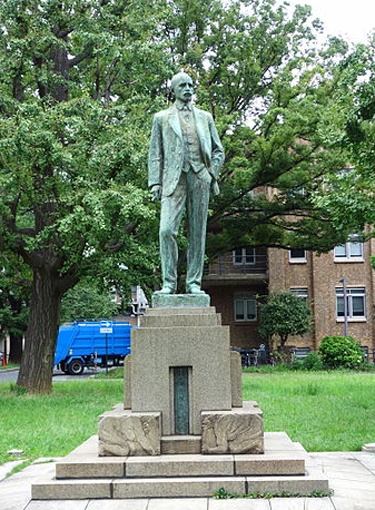Artist:
Chuta Ito
Title:
Josiah Conder Statue
Year:
1921
Adress:
University Of Tokyo
www.wikipedia.com:
Josiah Conder (28 September 1852 – 21 June 1920) was a British architect who worked as a foreign adviser to the government of Meiji period Japan.
Conder designed numerous public buildings in Tokyo, including the Rokumeikan, which became a controversial symbol of Westernisation in the Meiji period. He educated many award-winning Japanese architects (notably Tatsuno Kingo and Katayama T?kuma), earning him the nickname "father of Japanese modern architecture."
www.shinobazu-prj.jp:
The Statue of Josiah Conder today stands in the tranquil campus of the Faculty of Engineering, the University of Tokyo and seems to have been a part of this landscape since the beginning. Situated off center of this garden area and facing south with the Faculty of Engineering Building 1 at his back, this full-length monument does not intimidate or inspire awe from the passers-by but creates an atmosphere of intimacy. Sometimes people picnic in the lawn around the statue.
Originally from Great Britain, Conder (1852-1920) was hired by the Meiji government at the age of 25 and became a popular designer of both government and private buildings. His works include Rokumeikan (taken down in 1940 for more efficient use of the land), the old building of The Tokyo National Museum (damaged in the 1923 Great Kanto earthquake), and Kyu-Iwasaki-tei (the previous mansion of the Mitsubishi Family) in Yushima. He studied under Kawanabe Kyosai (1831-1889), an ukiyo-e artist and cultivated the new generation of Japanese architects including Tatsuno Kingo (1854-1919) and Katayama Tokuma (1854-1917) as a teacher at Kobudaigakou, the predecessor of the Faculty of Engineering, the University of Tokyo.
This statue, produced two years after Condor’s death, was designed by Ito Chuta (1867-1954), an architect and architecture historian, and sculpted by Shinkai Taketaro (1868-1927). Ito had no particular connection with Condor, however, he was a student of Tatsuno Kingo. This lineage again demonstrates the significance of Condor in the history of modern Japanese architecture.
Josiah Conder (28 September 1852 – 21 June 1920) was a British architect who worked as a foreign adviser to the government of Meiji period Japan.
Conder designed numerous public buildings in Tokyo, including the Rokumeikan, which became a controversial symbol of Westernisation in the Meiji period. He educated many award-winning Japanese architects (notably Tatsuno Kingo and Katayama T?kuma), earning him the nickname "father of Japanese modern architecture."
www.shinobazu-prj.jp:
The Statue of Josiah Conder today stands in the tranquil campus of the Faculty of Engineering, the University of Tokyo and seems to have been a part of this landscape since the beginning. Situated off center of this garden area and facing south with the Faculty of Engineering Building 1 at his back, this full-length monument does not intimidate or inspire awe from the passers-by but creates an atmosphere of intimacy. Sometimes people picnic in the lawn around the statue.
Originally from Great Britain, Conder (1852-1920) was hired by the Meiji government at the age of 25 and became a popular designer of both government and private buildings. His works include Rokumeikan (taken down in 1940 for more efficient use of the land), the old building of The Tokyo National Museum (damaged in the 1923 Great Kanto earthquake), and Kyu-Iwasaki-tei (the previous mansion of the Mitsubishi Family) in Yushima. He studied under Kawanabe Kyosai (1831-1889), an ukiyo-e artist and cultivated the new generation of Japanese architects including Tatsuno Kingo (1854-1919) and Katayama Tokuma (1854-1917) as a teacher at Kobudaigakou, the predecessor of the Faculty of Engineering, the University of Tokyo.
This statue, produced two years after Condor’s death, was designed by Ito Chuta (1867-1954), an architect and architecture historian, and sculpted by Shinkai Taketaro (1868-1927). Ito had no particular connection with Condor, however, he was a student of Tatsuno Kingo. This lineage again demonstrates the significance of Condor in the history of modern Japanese architecture.



